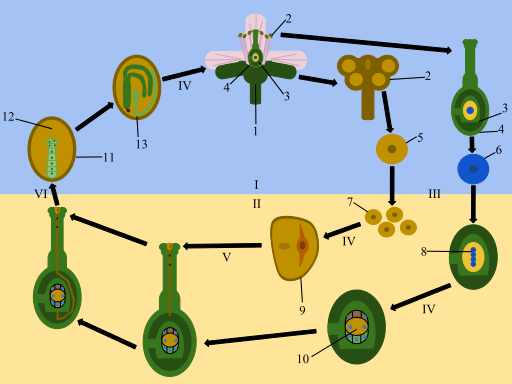Difference Between External and Internal Fertilization
The key difference between external and internal fertilization is that the union of male and female gametes in external fertilization occurs outside the female body while the union of male and female gametes in internal fertilization occurs inside the female body.
Fertilization is the most important event that takes place in sexual reproduction. In other words, it is the vital process that creates an offspring from two parents. Two types of gametes; male gamete and female gamete unite with each other during the fertilization. Hence, fertilization can be seen only in sexual reproduction. Gametes are haploid, and when they fuse with each other, it produces a diploid cell called zygote. Then, the mitosis divides the zygote and develops into a new individual. Here, there are two types of fertilizations based on the way they occur. They are the external fertilization and internal fertilization. External fertilization, as the name implies, occurs outside the female body while the internal fertilization occurs inside the female body.
CONTENTS
1. Overview and Key Difference
2. What is External Fertilization
3. What is Internal Fertilization
4. Similarities Between External and Internal Fertilization
5. Side by Side Comparison – External vs Internal Fertilization in Tabular Form
6. Summary
What is External Fertilization?
External fertilization is a type of fertilization in which the fusion male and female gametes occur externally of the female body. Hence, external fertilization needs water to facilitate their fertilization. Therefore, external fertilization mainly takes place in wet environments. Unlike the internal fertilization, both, male and female gametes release into the environment, especially to the water, so that male gametes can swim towards the female gametes for syngamy. Hence, the organisms which show external fertilization should live in water or they should go to watery environments for reproduction. Special feature of the male gametes is that they are motile.

Figure 01: External Fertilization – Eggs released into the Water
Also, this type of fertilization mainly occurs in lower plants. Furthermore, some animals such as amphibians and fish show external fertilization. However, there are some disadvantages associated with external fertilization such as the requirement of releasing a large number of gametes, having a low survival rate of the embryo, lack of parental care, etc.
What is Internal Fertilization?
Internal fertilization is the second type of fertilization that occurs within the female body. During the internal fertilization, male organism deposits its gametes inside the female organisms. Therefore, the union of the male and female gametes occurs inside the female body. Once the fertilization completes, the zygote develops within the female organisms until the birth of the offspring. Hence, this mode of fertilization mainly protects the female gamete.

Figure 02: Internal Fertilization
Furthermore, the embryo gets more protection from predation and harsh environmental conditions, so it has a higher survival rate. Also, there is no need of producing a large number of female gametes (eggs) since they locate inside the female body. Likewise, there are several advantages associated with internal fertilization over external fertilization. This type of fertilization is common in birds, reptiles and mammals.
What are the Similarities Between External and Internal Fertilization?
- External and internal fertilization are two types of fertilization occur in sexual reproduction.
- In both types, a male and a female gamete fuse with each other.
- Also, both results a diploid zygote.
- Furthermore, both produce genetically different offspring.
What is the Difference Between External and Internal Fertilization?
External and internal fertilization are two types of fertilization methods seen in sexual reproduction. The major difference between external and internal fertilization is that the external fertilization occurs outside the female body while the internal fertilization occurs inside the female body. As a result, there should be an external medium like water for the external fertilization to happen whereas it is not needed in internal fertilization as it happens inside the female body. There are more differences between these two types of fertilizations.
The following infographic illustrates more facts regarding the difference between external and internal fertilization.

Summary – External vs Internal Fertilization
As the names suggest, external fertilization occurs outside the body whereas, internal fertilization occurs inside the female body. This is the main difference between external and internal fertilization. During the external fertilization, male and female organisms release their gametes into the environment. On the other hand, during the internal fertilization, male organism deposits male gametes inside the female organism. Hence, the union of male and female gametes takes place inside the female body, and the developed zygote matures inside the mother organism. Since internal fertilization is more concerned about the protection of the fertilized egg or the embryo, it is not necessary to produce a large number of female gametes. It is one of the advantages of internal fertilization over external fertilization. Furthermore, embryo gets parental care, and the high survival rates of the offspring are some other advantages of internal fertilization.
Reference:
1.Learning, Lumen. “Biology for Majors II.” Lumen. Available here
2.Alberts, Bruce. “Fertilization.” Molecular Biology of the Cell. 4th Edition., U.S. National Library of Medicine, 1 Jan. 1970. Available here
Image Courtesy:
1.”1378058″ by TheUjulala (CC0) via pixabay
2.”Plant Fertilization Cycle”By TheLAW14 – Own work, (CC BY-SA 3.0) via Commons Wikimedia
ncG1vNJzZmivp6x7pbXFn5yrnZ6YsqOx07CcnqZemLyue8OinZ%2Bdopq7pLGMm5ytr5Wau26x162cq6aRoXqiusNmraxlmaPBpr7NmqNmnpWnwaq4yLOYraGfo3w%3D